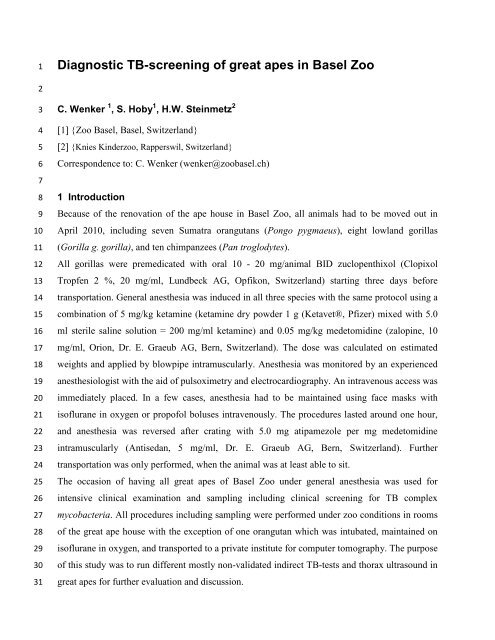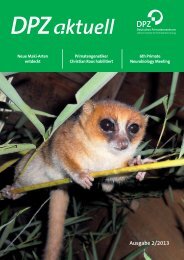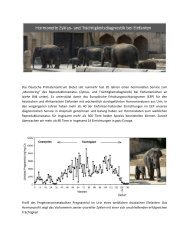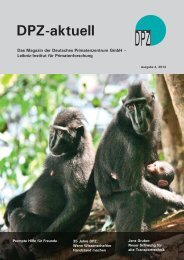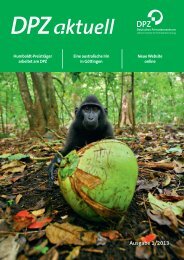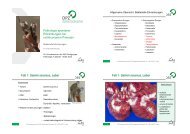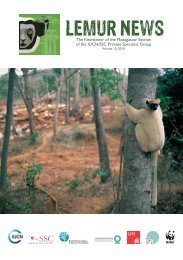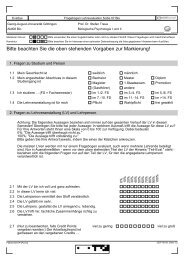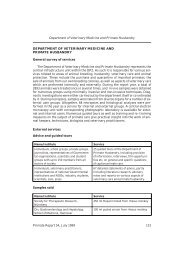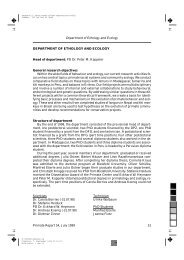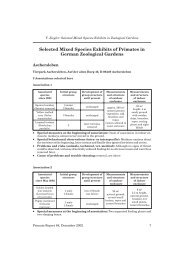Diagnostic TB screening of gret apes in Basel
Diagnostic TB screening of gret apes in Basel
Diagnostic TB screening of gret apes in Basel
Create successful ePaper yourself
Turn your PDF publications into a flip-book with our unique Google optimized e-Paper software.
1<br />
2<br />
3<br />
4<br />
5<br />
6<br />
7<br />
8<br />
9<br />
10<br />
11<br />
12<br />
13<br />
14<br />
15<br />
16<br />
17<br />
18<br />
19<br />
20<br />
21<br />
22<br />
23<br />
24<br />
25<br />
26<br />
27<br />
28<br />
29<br />
30<br />
31<br />
<strong>Diagnostic</strong> <strong>TB</strong>-<strong>screen<strong>in</strong>g</strong> <strong>of</strong> great <strong>apes</strong> <strong>in</strong> <strong>Basel</strong> Zoo<br />
C. Wenker 1 , S. Hoby 1 , H.W. Ste<strong>in</strong>metz 2<br />
[1] {Zoo <strong>Basel</strong>, <strong>Basel</strong>, Switzerland}<br />
[2] {Knies K<strong>in</strong>derzoo, Rapperswil, Switzerland}<br />
Correspondence to: C. Wenker (wenker@zoobasel.ch)<br />
1 Introduction<br />
Because <strong>of</strong> the renovation <strong>of</strong> the ape house <strong>in</strong> <strong>Basel</strong> Zoo, all animals had to be moved out <strong>in</strong><br />
April 2010, <strong>in</strong>clud<strong>in</strong>g seven Sumatra orangutans (Pongo pygmaeus), eight lowland gorillas<br />
(Gorilla g. gorilla), and ten chimpanzees (Pan troglodytes).<br />
All gorillas were premedicated with oral 10 - 20 mg/animal BID zuclopenthixol (Clopixol<br />
Tropfen 2 %, 20 mg/ml, Lundbeck AG, Opfikon, Switzerland) start<strong>in</strong>g three days before<br />
transportation. General anesthesia was <strong>in</strong>duced <strong>in</strong> all three species with the same protocol us<strong>in</strong>g a<br />
comb<strong>in</strong>ation <strong>of</strong> 5 mg/kg ketam<strong>in</strong>e (ketam<strong>in</strong>e dry powder 1 g (Ketavet®, Pfizer) mixed with 5.0<br />
ml sterile sal<strong>in</strong>e solution = 200 mg/ml ketam<strong>in</strong>e) and 0.05 mg/kg medetomid<strong>in</strong>e (zalop<strong>in</strong>e, 10<br />
mg/ml, Orion, Dr. E. Graeub AG, Bern, Switzerland). The dose was calculated on estimated<br />
weights and applied by blowpipe <strong>in</strong>tramuscularly. Anesthesia was monitored by an experienced<br />
anesthesiologist with the aid <strong>of</strong> pulsoximetry and electrocardiography. An <strong>in</strong>travenous access was<br />
immediately placed. In a few cases, anesthesia had to be ma<strong>in</strong>ta<strong>in</strong>ed us<strong>in</strong>g face masks with<br />
is<strong>of</strong>lurane <strong>in</strong> oxygen or prop<strong>of</strong>ol boluses <strong>in</strong>travenously. The procedures lasted around one hour,<br />
and anesthesia was reversed after crat<strong>in</strong>g with 5.0 mg atipamezole per mg medetomid<strong>in</strong>e<br />
<strong>in</strong>tramuscularly (Antisedan, 5 mg/ml, Dr. E. Graeub AG, Bern, Switzerland). Further<br />
transportation was only performed, when the animal was at least able to sit.<br />
The occasion <strong>of</strong> hav<strong>in</strong>g all great <strong>apes</strong> <strong>of</strong> <strong>Basel</strong> Zoo under general anesthesia was used for<br />
<strong>in</strong>tensive cl<strong>in</strong>ical exam<strong>in</strong>ation and sampl<strong>in</strong>g <strong>in</strong>clud<strong>in</strong>g cl<strong>in</strong>ical <strong>screen<strong>in</strong>g</strong> for <strong>TB</strong> complex<br />
mycobacteria. All procedures <strong>in</strong>clud<strong>in</strong>g sampl<strong>in</strong>g were performed under zoo conditions <strong>in</strong> rooms<br />
<strong>of</strong> the great ape house with the exception <strong>of</strong> one orangutan which was <strong>in</strong>tubated, ma<strong>in</strong>ta<strong>in</strong>ed on<br />
is<strong>of</strong>lurane <strong>in</strong> oxygen, and transported to a private <strong>in</strong>stitute for computer tomography. The purpose<br />
<strong>of</strong> this study was to run different mostly non-validated <strong>in</strong>direct <strong>TB</strong>-tests and thorax ultrasound <strong>in</strong><br />
great <strong>apes</strong> for further evaluation and discussion.
1<br />
2<br />
3<br />
4<br />
5<br />
6<br />
7<br />
8<br />
9<br />
10<br />
11<br />
12<br />
13<br />
14<br />
15<br />
16<br />
17<br />
18<br />
19<br />
20<br />
21<br />
22<br />
23<br />
24<br />
25<br />
26<br />
27<br />
28<br />
29<br />
30<br />
31<br />
32<br />
2 Methods for diagnostic <strong>TB</strong>-<strong>screen<strong>in</strong>g</strong><br />
Comparative <strong>in</strong>trapalpebral tubercul<strong>in</strong> tests were performed us<strong>in</strong>g 0.1 ml tubercul<strong>in</strong> PPD (= 2000<br />
IU) RT 23 SSI (2 TE/0.1 ml) (Statens Serum Institute, Copenhagen, Denmark, distributed by Pro<br />
Vacc<strong>in</strong>e AG, Baar, Switzerland) <strong>in</strong> the left eyelid and 0.1 ml bovituber PPD (= 2000 IU)<br />
(Synbiotics Europe, Lyon, France) <strong>in</strong> the right eyelid. The reaction was visually <strong>in</strong>spected daily<br />
and determ<strong>in</strong>ed after 72 hours.<br />
Two different commercial <strong>in</strong>terferon gamma tests were used (Primagam®, Prionics, USA, Inc,<br />
La Vista, NE and QuantiFERON Gold®, Celestis, Australia). For the Primagam® test<br />
hepar<strong>in</strong>ized blood was sent to the laboratory on the same day. For the QuantiFERON Gold® test<br />
whole blood was <strong>in</strong>cubated for lymphocytestimulation <strong>in</strong> the zoo at 37° Celsius for 16-24 hours,<br />
then centrifugated, and a plasma sample was sent to the laboratory.<br />
To detect antibodies <strong>of</strong> M. tuberculosis <strong>in</strong> the blood sera, the Prima-<strong>TB</strong> STAT-PAK® (ChemBio<br />
<strong>Diagnostic</strong> Systems, Inc, Medford, NY) was used. The results were visually <strong>in</strong>spected after 20<br />
m<strong>in</strong>utes, and photographs were taken for documentation.<br />
Pharyngeal swabs were taken and submitted for rpoB-PCR exam<strong>in</strong>ation (Kim et al., 1999). The<br />
rpoB-gene encodes the β-subunit <strong>of</strong> the RNA polymerase. The primer detects the 342 bp DNA<br />
fragment and confirms the presence <strong>of</strong> the genus Mycobacterium. Further identification down to<br />
the species level can be achieved by sequence or restriction analysis <strong>of</strong> f<strong>in</strong>gerpr<strong>in</strong>ts. This was the<br />
only direct test used <strong>in</strong> this study.<br />
Ventro-dorsal thorax ultrasound was performed by plac<strong>in</strong>g the anesthetized animal <strong>in</strong> a sitt<strong>in</strong>g<br />
upright position on a fenced cage door with the aid <strong>of</strong> mounta<strong>in</strong> climb<strong>in</strong>g gear to fix the arms.<br />
The detector cassette was also fixed at the door (Fig. 1).<br />
No thorax X-rays were taken from two chimpanzee mothers with babies on their chests. The X-<br />
rays were <strong>in</strong>terpreted by two <strong>in</strong>dependent board-certified radiologists (1 DM and 1 DVM).<br />
3 Results<br />
All animals were apparently healthy with the exception <strong>of</strong> age-related teeth and/or jo<strong>in</strong>t<br />
problems. Four gorillas were found to be affected by hepatic alveolar ech<strong>in</strong>ococcosis confirmed<br />
sonographically, by ELISA, and Western Blot. Oral herpes-like-lesions were present <strong>in</strong> a young<br />
male chimpanzee and were associated with Pan troglodytes lymphocryptovirus 1.<br />
Results <strong>of</strong> diagnostic <strong>TB</strong>-test<strong>in</strong>g are summarized for the different ape species <strong>in</strong> tables 1-3.
1<br />
2<br />
3<br />
4<br />
5<br />
6<br />
7<br />
8<br />
9<br />
10<br />
11<br />
12<br />
13<br />
14<br />
15<br />
16<br />
17<br />
18<br />
19<br />
20<br />
21<br />
22<br />
23<br />
24<br />
25<br />
26<br />
27<br />
28<br />
29<br />
30<br />
31<br />
4 Discussion<br />
<strong>Diagnostic</strong> <strong>TB</strong> <strong>screen<strong>in</strong>g</strong> can easily be performed dur<strong>in</strong>g general anesthesia <strong>of</strong> great <strong>apes</strong> under<br />
zoo field conditions. However, a well prepared protocol and staff is needed and laboratories have<br />
to be contacted beforehand. In this study, a variety <strong>of</strong> results was obta<strong>in</strong>ed for <strong>in</strong>direct tests and<br />
thorax X-ray <strong>in</strong>terpretations, while the only direct test performed (PCR pharyngeal swabs) was<br />
negative for all tested animals. Interpretation <strong>of</strong> this comb<strong>in</strong>ed test<strong>in</strong>g is challeng<strong>in</strong>g, and neither<br />
the presence nor absence <strong>of</strong> <strong>TB</strong> complex mycobacteria <strong>in</strong> the tested great <strong>apes</strong> could be<br />
conclusively determ<strong>in</strong>ed.<br />
We observed positive <strong>in</strong>trapalbebral M. bovis tubercul<strong>in</strong> tests <strong>in</strong> one orangutan (after 96 hours),<br />
one questionable m<strong>in</strong>or reaction <strong>in</strong> one gorilla, and <strong>in</strong> four chimpanzees. All animals were tested<br />
negative for M. tuberculosis tubercul<strong>in</strong>. Cell-mediated immunologic tests like the <strong>in</strong>tradermal test<br />
are known to have limitations and they can produce false-positive or false-negative reactions.<br />
Some species like orangutans, tapirs, bongo antelopes, and re<strong>in</strong>deer have an <strong>in</strong>creased likelihood<br />
<strong>of</strong> nonspecific reactions (Miller, 2008). Therefore, further test<strong>in</strong>g is required <strong>in</strong>clud<strong>in</strong>g sk<strong>in</strong> tests<br />
for M. avium to rule out cross-reactivity.<br />
One chimpanzee was tested positive <strong>in</strong> the Quantiferon-<strong>TB</strong> Gold® assay but was negative <strong>in</strong> the<br />
Primagam® test. This test result may be expla<strong>in</strong>ed by differences <strong>in</strong> sample process<strong>in</strong>g,<br />
lymphocyte stimulation or different cut-<strong>of</strong>f levels used by the different laboratories.<br />
The Prima<strong>TB</strong> StatPak® test was positive for one orangutan and one gorilla. This fast test detects<br />
antibodies <strong>of</strong> M. tuberculosis with a comb<strong>in</strong>ation <strong>of</strong> selected antigens. It uses lateral flow<br />
technology and was evaluated <strong>in</strong> 422 nonhuman primates (rhesus monkey, cynomolgus monkey,<br />
African green monkey) (Lyashchenko et al. 2007). The sensitivity was 90 % and the specifity 99<br />
%. Best results were achieved <strong>in</strong> comb<strong>in</strong>ation with the sk<strong>in</strong> test. However, this test has not been<br />
validated for great <strong>apes</strong> and does not detect M. bovis. A currently commercially not available<br />
multiantigen pr<strong>in</strong>t immunoassay (MAPIA) will be carried out on these samples and may provide<br />
further results.<br />
Interest<strong>in</strong>gly, <strong>in</strong>terpretation <strong>of</strong> thorax x-rays showed no accordance at all between a human and<br />
veter<strong>in</strong>ary radiologist. In human <strong>TB</strong> cases, lung lesions are <strong>of</strong>ten associated with calcifications<br />
that are easy to detect on radiographs. This feature is rare or absent <strong>in</strong> animals. However, both<br />
radiologists did not see clear evidence <strong>of</strong> typcial <strong>TB</strong> lesions. Both exam<strong>in</strong>ersmentioned other
1<br />
2<br />
3<br />
4<br />
5<br />
6<br />
7<br />
8<br />
9<br />
10<br />
11<br />
12<br />
13<br />
14<br />
15<br />
16<br />
17<br />
18<br />
19<br />
20<br />
21<br />
22<br />
23<br />
24<br />
25<br />
26<br />
27<br />
28<br />
29<br />
30<br />
31<br />
32<br />
differential diagnoses <strong>in</strong> their <strong>in</strong>terpretations. The veter<strong>in</strong>ary radiologist criticized the absence <strong>of</strong><br />
an additional latero-lateral x-ray that would have been helpful for better <strong>in</strong>terpretation.<br />
Us<strong>in</strong>g the comb<strong>in</strong>ation <strong>of</strong> the different <strong>screen<strong>in</strong>g</strong> tests, there was only one chimpanzee, which<br />
showed positive results <strong>in</strong> more than one test (positive M. bovis sk<strong>in</strong> test, positive Quantiferon-<br />
<strong>TB</strong> Gold®, questionable positive x-ray <strong>in</strong>terpretation <strong>of</strong> the human radiologist) (table 3). This<br />
<strong>in</strong>dividual has a history <strong>of</strong> close contact to humans because <strong>of</strong> historical animal trade activities.<br />
Therefore, this animal needs careful observation and further test<strong>in</strong>g.<br />
All the great <strong>apes</strong> will be moved back to the ape house <strong>in</strong> spr<strong>in</strong>g 2011 with the need <strong>of</strong> another<br />
general anesthesia. This will give us the opportunity to repeat and perform further tests. It is<br />
planned to perform more direct test<strong>in</strong>g <strong>of</strong> excretions, body fluids and tissues (gastric lavage,<br />
tracheo-bronchial lavage, faeces, tissue with lesions) us<strong>in</strong>g acid-fast sta<strong>in</strong><strong>in</strong>g, culture and<br />
molecular assays <strong>in</strong> comb<strong>in</strong>ation. Amplified M. tuberculosis direct test (MTD) and multiplex<br />
PCR may be used to dist<strong>in</strong>guish pathogenic <strong>in</strong>fections from atypical <strong>in</strong>fections that may cause<br />
positive test results. Any other ideas from the community <strong>of</strong> primate and zoo veter<strong>in</strong>arians as<br />
well as physicians and bacteriologists are very welcome and should be addressed to the<br />
correspond<strong>in</strong>g author.<br />
If <strong>screen<strong>in</strong>g</strong> great ape collections for <strong>TB</strong>, one has to consider consequences <strong>of</strong> positive results<br />
before test<strong>in</strong>g is performed, <strong>in</strong>clud<strong>in</strong>g those for the <strong>in</strong>dividual animal, the personnel, the<br />
authorities, the studbook and associated animal transfer affairs, the public, the media, and further<br />
capacities.<br />
5 Conclusion<br />
There is no ante mortem <strong>TB</strong> test for the great <strong>apes</strong>, which is 100 % reliable. Multiple test<br />
modalities have to be performed, although <strong>in</strong> this study even the comb<strong>in</strong>ation <strong>of</strong> six tests did not<br />
br<strong>in</strong>g a satisfy<strong>in</strong>g reliability. It has to be considered that most tests are not validated for great<br />
<strong>apes</strong>. Certa<strong>in</strong> zoo species <strong>in</strong>clud<strong>in</strong>g orangutans are known to have an <strong>in</strong>creased likelihood <strong>of</strong><br />
nonspecific reactions <strong>in</strong> the sk<strong>in</strong> test. Interpretation <strong>of</strong> thorax x-rays by different radiologists also<br />
revealed <strong>in</strong>conclusive results.<br />
From the results <strong>of</strong> this study, we carefully assume that we do not have M. tuberculosis <strong>in</strong> the<br />
tested animals. However, we are not sure about the presence <strong>of</strong> M. bovis or atypical or non-<br />
tuberculous mycobacteria. We will therefore repeat all tests on a scientific basis and perform a<br />
triple comb<strong>in</strong>ation <strong>of</strong> sk<strong>in</strong> tests <strong>in</strong>clud<strong>in</strong>g M. tuberculosis, M. bovis, and M. avium tubercul<strong>in</strong> to
1<br />
2<br />
3<br />
4<br />
5<br />
6<br />
7<br />
8<br />
9<br />
10<br />
detect cross-reactions. The next protocol will also <strong>in</strong>clude more direct test<strong>in</strong>g <strong>of</strong> excretions,<br />
lavage fluids and tissues, us<strong>in</strong>g acid-fast sta<strong>in</strong><strong>in</strong>g, culture, and molecular assays <strong>in</strong> comb<strong>in</strong>ation.<br />
Table 1. <strong>Diagnostic</strong> <strong>TB</strong> <strong>screen<strong>in</strong>g</strong> <strong>of</strong> Sumatra orangutans <strong>in</strong> <strong>Basel</strong> Zoo.<br />
1.6<br />
Orangutan<br />
1.0 = male<br />
0.1 = female<br />
Sk<strong>in</strong> Test<br />
(72h)<br />
M.<br />
tuberculosis<br />
Sk<strong>in</strong> Test<br />
(72h)<br />
M. bovis<br />
Quantiferon-<br />
<strong>TB</strong> Gold®<br />
0.1<br />
Sexta<br />
1.0<br />
Schubbi<br />
0.1<br />
Ogan<br />
0.1<br />
Ziadah<br />
0.1<br />
Farida<br />
0.1<br />
Elsy<br />
0.1<br />
Kasih<br />
- - - - - - -<br />
-<br />
+<br />
(96h)<br />
- - - - - -<br />
- n.d. - n.d. - - -<br />
Primagam® - - - - - - -<br />
Prima <strong>TB</strong><br />
StatPak®<br />
X-ray Thorax<br />
Human MD<br />
X-ray Thorax<br />
DVM<br />
- + - - - - -<br />
-<br />
CT<br />
n.d. (+)<br />
osteoma?<br />
*other pathology<br />
n.d. = test not done<br />
CT = computer tomography<br />
- - - +<br />
DD<br />
granuloma<br />
- -*<br />
- - - - -
1<br />
2<br />
3<br />
4<br />
5<br />
6<br />
7<br />
8<br />
Table 2. <strong>Diagnostic</strong> <strong>TB</strong> <strong>screen<strong>in</strong>g</strong> <strong>of</strong> lowland gorillas <strong>in</strong> <strong>Basel</strong> Zoo.<br />
2.6 Gorillas<br />
1.0 = male<br />
0.1 = female<br />
Sk<strong>in</strong> Test<br />
(72h)<br />
M.<br />
tuberculosis<br />
Sk<strong>in</strong> Test<br />
(72h)<br />
M. bovis<br />
Quantiferon-<br />
<strong>TB</strong> Gold®<br />
1.0<br />
Kisoro<br />
0.1<br />
Faddama<br />
0.1<br />
Goma<br />
0.1<br />
Zungu<br />
0.1<br />
Joas<br />
0.1<br />
Quarta<br />
0.1<br />
Wima<br />
0.1<br />
Chelewa<br />
- - - - - - - -<br />
(+) - - - - - - -<br />
- - - - - - - -<br />
Primagam® - - - - - - - -<br />
Prima <strong>TB</strong><br />
StatPak®<br />
rpoB-PCR<br />
Pharnyx swap<br />
X-ray Thorax<br />
Human MD<br />
X-ray Thorax<br />
DVM<br />
- + - - - - - -<br />
- - - - - - - -<br />
-<br />
AE<br />
-<br />
(AE)<br />
- +<br />
DD<br />
granuloma<br />
or lung<br />
cyst<br />
*other pathology<br />
n.d. = test not done<br />
AE = confirmed alveolar ech<strong>in</strong>ococcosis<br />
† = animal died<br />
- -<br />
AE<br />
- -*<br />
AE<br />
- - - -*<br />
AE<br />
n.d.<br />
AE†<br />
n.d.<br />
n.d. n.d.
1<br />
2<br />
3<br />
4<br />
5<br />
6<br />
7<br />
8<br />
9<br />
10<br />
11<br />
12<br />
Table 3. <strong>Diagnostic</strong> <strong>TB</strong> <strong>screen<strong>in</strong>g</strong> <strong>of</strong> chimpanzees <strong>in</strong> <strong>Basel</strong> Zoo.<br />
3.5<br />
chimpanzee<br />
1.0 = male<br />
0.1 = female<br />
Sk<strong>in</strong> Test<br />
(72h)<br />
M.<br />
tuberculosis<br />
Sk<strong>in</strong> Test<br />
(72h)<br />
M. bovis<br />
Quantiferon-<br />
<strong>TB</strong> Gold®<br />
0.1<br />
Zamana<br />
0.1<br />
X<strong>in</strong>dra<br />
0.1<br />
Quamisha<br />
0.1<br />
Jacky<br />
0.1<br />
Benga<br />
1.0<br />
Wakili<br />
1.0<br />
Eros<br />
1.0<br />
Colebe<br />
- - - - - - - -<br />
- + - + (+) (+) - -<br />
- - - + - - - -<br />
Primagam® - - - - - - - -<br />
Prima <strong>TB</strong><br />
StatPak®<br />
rpoB-PCR<br />
Pharynx swap<br />
X-ray Thorax<br />
Human MD<br />
X-ray Thorax<br />
DVM<br />
*other pathology<br />
n.d. = test not done, baby on the chest<br />
- - - - - - - -<br />
- - - - - - - -<br />
- n.d. - - n.d. - -* -<br />
- n.d. - (+) n.d. - - -
1<br />
2<br />
3<br />
4<br />
5<br />
6<br />
7<br />
8<br />
9<br />
10<br />
11<br />
12<br />
13<br />
14<br />
15<br />
16<br />
17<br />
18<br />
19<br />
Figure 1. Ventrodorsal thorax x-ray <strong>of</strong> a male anesthetized orangutan. The animal is fixed <strong>in</strong> a<br />
sitt<strong>in</strong>g and upright position on a cage door to obta<strong>in</strong> optimal results.<br />
Acknowledgments<br />
We thank many persons, without their <strong>in</strong>dispensable help this study would not have been<br />
possible: Bernard Mengiardi, Renate Vögtli, Mart<strong>in</strong>a Wicki, Thomas Bodmer, Max Wittenbr<strong>in</strong>k,<br />
Gabriela Hürlimann, Pia Kraw<strong>in</strong>kel, Chiara Adami, N<strong>in</strong>a Zimmermann, Suzanne Aebi, Jakob<br />
Huber, Bruno Seiffert, Thomas Jermann and all <strong>in</strong>volved keepers and craftsmen <strong>of</strong> the <strong>Basel</strong> Zoo.<br />
References<br />
Bushmitz, M., Lécu, A., Verreck, F., Preuss<strong>in</strong>g, E., Rens<strong>in</strong>g, S., and Mätz-Rens<strong>in</strong>g, K.:<br />
Guidel<strong>in</strong>es for the prevention and control <strong>of</strong> tuberculosis <strong>in</strong> nonhuman primates:<br />
recommendations <strong>of</strong> the European Primate Veter<strong>in</strong>ary Association Work<strong>in</strong>g Group on<br />
Tuberculosis. J. Med. Primatol., 38, 59-69, 2009.
1<br />
2<br />
3<br />
4<br />
5<br />
6<br />
7<br />
8<br />
9<br />
10<br />
11<br />
Kim, B.J., Lee, S.H., Lyu, M.E. et al.: Identification <strong>of</strong> mycobacterial species by comparative<br />
sequence analysis <strong>of</strong> the RNA polymerase gene (rpoB). J. Cl<strong>in</strong>ical Microbiol. 37 (6), 1714-1720,<br />
1999.<br />
Lyashchenko, K.P., Greenwald, L., Esfandiari, J., Greenwald, D., Nacy, C.A., Gibson, S., Didier,<br />
P. J., Wash<strong>in</strong>gton, M., Szczerba, P. and Motzel, S. : Prima<strong>TB</strong> STAT-PAK assay, a novel, rapid<br />
lateral-flow test for tuberculosis <strong>in</strong> nonhuman primates. Cl<strong>in</strong>ical and Vacc<strong>in</strong>e Immunology 14<br />
(9), 1158-1164, 2007.<br />
Miller, M.A.: Current diagnostic methods for tuberculosis <strong>in</strong> zoo animals. In: Zoo and Wild<br />
Animal Medic<strong>in</strong>e, Current Therapy 6, Fowler M.E. and Miller E.R. (eds.), 10-19, 2008.


